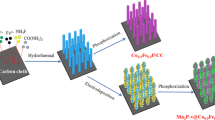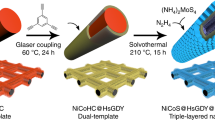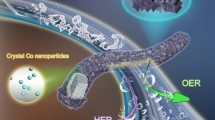Abstract
The advancement of electrocatalytic N2 reduction reaction (NRR) toward ambient NH3 synthesis lies in the development of more affordable electrocatalysts than noble metals. Recently, various nanostructures of transition metal compounds have been proposed as effective electrocatalysts; however, they exist in the form of loose powders, which have to be immobilized on a matrix before serving as the electrode for electrolysis. The matrix, being it carbon paper, carbon cloth or metal foam, is electrocatalytically inactive, whose introduction inevitably raises the invalid weight while sacrificing the active sites of the electrode. Herein, we report on the fabrication of a flexible ZrO2 nanofibrous membrane as a novel, self-supported electrocatalyst. The heteroatom doping can not only endow the nanofibrous membrane with excellent flexibility, but also induce oxygen vacancies which are responsible for easier adsorption of N2 on the ZrO2 surface. To improve the electrocatalytic activity, a facile SILAR approach is employed to decorate it with CdS quantum dots (QDs), thereby tuning its Fermi level. To improve the conductivity, a g-C3N4 nanolayer is further deposited which is both conductive and active. The resulting hierarchically structured, self-supported electrocatalyst, consisting of g-C3N4 encapsulated ZrO2 nanofibrous membrane decorated with CdS QDs, integrates the merits of the three components, and exhibits a remarkable synergy toward NRR. Excellent NH3 yield of 6.32 × 10−10 mol·s−1cm−2 (−0.6 V vs. RHE) and Faradaic efficiency of 12.9% (−0.4 V vs. RHE) are attained in 0.1 M Na2SO4.

Similar content being viewed by others
References
Guo, X. X.; Du, H. T.; Qu, F. L.; Li, J. H. Recent progress in electrocatalytic nitrogen reduction. J. Mater. Chem. A 2019, 7, 3531–3543.
Wang, Q. C.; Lei, Y. P.; Wang, D. S.; Li, Y. D. Defect engineering in earth-abundant electrocatalysts for CO2 and N2 reduction. Energy Environ. Sci. 2019, 12, 1730–1750.
Xue, X. L.; Chen, R. P.; Yan, C. Z.; Zhao, P. Y.; Hu, Y.; Zhang, W. J.; Yang, S. Y.; Jin, Z. Review on photocatalytic and electrocatalytic artificial nitrogen fixation for ammonia synthesis at mild conditions: Advances, challenges and perspectives. Nano Res. 2019, 12, 1229–1249.
Cao, N.; Zheng, G. F. Aqueous electrocatalytic N2 reduction under ambient conditions. Nano Res. 2018, 11, 2992–3008.
Yang, Y. J.; Wang, S. Q.; Wen, H. M.; Ye, T.; Chen, J.; Li, C. P.; Du, M. Nanoporous gold embedded ZIF composite for enhanced electrochemical nitrogen fixation. Angew. Chem., Int. Ed. 2019, 58, 15362–15366.
Li, S. J.; Bao, D.; Shi, M. M.; Wulan, B. R.; Yan, J. M.; Jiang, Q. Amorphizing of Au nanoparticles by CeOx-RGO hybrid support towards highly efficient electrocatalyst for N2 reduction under ambient conditions. Adv. Mater. 2017, 29, 1700001.
Shi, M. M.; Bao, D.; Wulan, B. R.; Li, Y. H.; Zhang, Y. F.; Yan, J. M.; Jiang, Q. Au sub-nanoclusters on TiO2 toward highly efficient and selective electrocatalyst for N2 conversion to NH3 at ambient conditions. Adv. Mater. 2017, 29, 1606550.
Deng, G. R.; Wang, T.; Alshehri, A. A.; Alzahrani, K. A.; Wang, Y.; Ye, H. J.; Luo, Y. L.; Sun, X. P. Improving the electrocatalytic N2 reduction activity of Pd nanoparticles through surface modification. J. Mater. Chem. A 2019, 7, 21674–21677.
Tao, H. C.; Choi, C.; Ding, L. X.; Jiang, Z.; Han, Z. S.; Jia, M. W.; Fan, Q.; Gao, Y. N.; Wang, H. H.; Robertson, A. W. et al. Nitrogen fixation by Ru single-atom electrocatalytic reduction. Chem 2019, 5, 204–214.
Zheng, J. W.; Liao, F. L.; Wu, S.; Jones, G.; Chen, T. Y.; Fellowes, J.; Sudmeier, T.; McPherson, I. J.; Wilkinson, I.; Tsang, S. C. E. Efficient non-dissociative activation of dinitrogen to ammonia over lithium-promoted ruthenium nanoparticles at low pressure. Angew. Chem., Int. Ed. 2019, 58, 17335–17341.
Geng, Z.; Liu, Y.; Kong, X.; Li, P.; Li, K.; Liu, Z.; Du, J.; Shu, M.; Si, R.; Zeng, J. Achieving a record-high yield rate of 120.9 \({\rm{\mu}}{{\rm{g}}_{{\rm{N}}{{\rm{H}}_3}}} \cdot \,{\rm{mg}}_{{\rm{Cat}}}^{- 1} \cdot {{\rm{h}}^{- 1}}\) for N2 electrochemical reduction over Ru single-atom catalysts. Adv. Mater. 2018, 30, 1803498.
Wang, H. J.; Li, Y. H.; Li, C. J.; Deng, K.; Wang, Z. Q.; Xu, Y.; Li, X. N.; Xue, H. R.; Wang, L. One-pot synthesis of bi-metallic PdRu tripods as an efficient catalyst for electrocatalytic nitrogen reduction to ammonia. J. Mater. Chem. A 2019, 7, 801–805.
Ren, X.; Zhao, J. X.; Wei, Q.; Ma, Y. J.; Guo, H. R.; Liu, Q.; Wang, Y.; Cui, G. W.; Asiri, A. M.; Li, B. H. et al. High-performance N2-to-NH3 conversion electrocatalyzed by Mo2C nanorod. ACS Cent. Sci. 2019, 5, 116–121.
Cheng, H.; Cui, P. X.; Wang, F. R.; Ding, L. X.; Wang, H. H. High efficiency electrochemical nitrogen fixation achieved with a lower pressure reaction system by changing the chemical equilibrium. Angew. Chem., Int. Ed. 2019, 58, 15541–15547.
Luo, Y.; Chen, G. F.; Ding, L.; Chen, X. Z.; Ding, L. X.; Wang, H. H. Efficient electrocatalytic N2 fixation with MXene under ambient conditions. Joule 2019, 3, 279–289.
Yang, X.; Kattel, S.; Nash, J.; Chang, X. X.; Lee, J. H.; Yan, Y. S.; Chen, J. G.; Xu, B. J. Quantification of active sites and elucidation of the reaction mechanism of the electrochemical nitrogen reduction reaction on vanadium nitride. Angew. Chem., Int. Ed. 2019, 58, 13768–13772.
Jin, H. Y.; Li, L. Q.; Liu, X.; Tang, C.; Xu, W. J.; Chen, S. M.; Song, L.; Zheng, Y.; Qiao, S. Z. Nitrogen vacancies on 2D layered W2N3: A stable and efficient active site for nitrogen reduction reaction. Adv. Mater. 2019, 31, 1902709.
Ren, X.; Cui, G. W.; Chen, L.; Xie, F. Y.; Wei, Q.; Tian, Z. Q.; Sun, X. P. Electrochemical N2 fixation to NH3 under ambient conditions: Mo2N nanorod as a highly efficient and selective catalyst. Chem. Commun. 2018, 54, 8474–8477.
Fang, W.; Zhao, J.; Wu, T.; Huang, Y. J.; Yang, L.; Liu, C. T.; Zhang, Q. C.; Huang, K.; Yan, Q. Y. Hydrophilic engineering of VOx-based nanosheets for ambient electrochemical ammonia synthesis at neutral pH. J. Mater. Chem. A 2020, 8, 5913–5918.
Du, Y. Q.; Jiang, C.; Song, L.; Gao, B.; Gong, H.; Xia, W.; Sheng, L.; Wang, T.; He, J. P. Regulating surface state of WO3 nanosheets by gamma irradiation for suppressing hydrogen evolution reaction in electrochemical N2 fixation. Nano Res. 2020, 13, 2784–2790.
Wang, Y.; Dai, J.; Zhang, M.; Liu, Y. T.; Yu, J. Y.; Ding, B. P-doped WO3 flowers fixed on a TiO2 nanofibrous membrane for enhanced electroreduction of N2. Chem. Commun. 2020, 56, 12937–12940.
Chen, P. Z.; Zhang, N.; Wang, S. B.; Zhou, T. P.; Tong, Y.; Ao, C. C.; Yan, W. S.; Zhang, L. D.; Chu, W. S.; Wu, C. Z. et al. Interfacial engineering of cobalt sulfide/graphene hybrids for highly efficient ammonia electrosynthesis. Proc. Natl. Acad. Sci. USA 2019, 116, 6635–6640.
Chu, K.; Wang, J.; Liu, Y. P.; Li, Q. Q.; Guo, Y. L. Mo-doped SnS2 with enriched S-vacancies for highly efficient electrocatalytic N2 reduction: The critical role of the Mo-Sn-Sn trimer. J. Mater. Chem. A 2020, 8, 7117–7124.
Li, D.; Chen, X. X.; Liu, Y. T.; Yu, J. Y.; Ding, B. Sb2S3 nanoparticles anchored on SnO2 nanofibers: A high-performance hybrid electrocatalyst toward ammonia synthesis under ambient conditions. Chem. Commun. 2019, 55, 13892–13895.
Yang, X.; Nash, J.; Anibal, J.; Dunwell, M.; Kattel, S.; Stavitski, E.; Attenkofer, K.; Chen, J. G.; Yan, Y. S.; Xu, B. J. Mechanistic insights into electrochemical nitrogen reduction reaction on vanadium nitride nanoparticles. J. Am. Chem. Soc. 2018, 140, 13387–13391.
Lv, C. D.; Yan, C. S.; Chen, G.; Ding, Y.; Sun, J. X.; Zhou, Y. S.; Yu, G. H. An amorphous noble-metal-free electrocatalyst that enables nitrogen fixation under ambient conditions. Angew. Chem., Int. Ed. 2018, 57, 6073–6076.
Zhang, L.; Ji, X. Q.; Ren, X.; Ma, Y. J.; Shi, X. F.; Tian, Z. Q.; Asiri, A. M.; Chen, L.; Tang, B.; Sun, X. P. Electrochemical ammonia synthesis via nitrogen reduction reaction on a MoS2 catalyst: Theoretical and experimental studies. Adv. Mater. 2018, 30, 1800191.
Zhang, X. P.; Kong, R. M.; Du, H. T.; Xia, L.; Qu, F. L. Highly efficient electrochemical ammonia synthesis via nitrogen reduction reactions on a VN nanowire array under ambient conditions. Chem. Commun. 2018, 54, 5323–5325.
Chen, X. X.; Liu, Y. T.; Ma, C. L.; Yu, J. Y.; Ding, B. Self-organized growth of flower-like SnS2 and forest-like ZnS nanoarrays on nickel foam for synergistic superiority in electrochemical ammonia synthesis. J. Mater. Chem. A 2019, 7, 22235–22241.
Wang, H. J.; Yu, H. J.; Wang, Z. Q.; Li, Y. H.; Xu, Y.; Li, X. N.; Xue, H. R.; Wang, L. Electrochemical fabrication of porous Au film on Ni foam for nitrogen reduction to ammonia. Small 2019, 15, 1804769.
Xiong, P.; Sun, B.; Sakai, N.; Ma, R. Z.; Sasaki, T.; Wang, S. J.; Zhang, J. P.; Wang, G. X. 2D superlattices for efficient energy storage and conversion. Adv. Mater. 2020, 32, 1902654.
Wu, Z. Y.; Wang, Y. N.; Zhang, L.; Jiang, L.; Tian, W. C.; Cai, C. L.; Price, J.; Gu, Q. F.; Hu, L. F. A layered Zn0.4VOPO4·0.8H2O cathode for robust and stable Zn ion storage. ACS Appl. Energy Mater. 2020, 3, 3919–3927.
Yang, P.; Wu, Z.; Jiang, Y.; Pan, Z.; Tian, W.; Jiang, L.; Hu, L. Fractal (NixCo1−x)9Se8 nanodendrite arrays with highly exposed (011) surface for wearable, all-solid-state supercapacitor. Adv. Energy Mater. 2018, 8, 1801392.
Jiang, Y. C.; Song, Y.; Li, Y. M.; Tian, W. C.; Pan, Z. C.; Yang, P. Y.; Li, Y. S.; Gu, Q. F.; Hu, L. F. Charge transfer in ultrafine LDH nanosheets/graphene interface with superior capacitive energy storage performance. ACS Appl. Mater. Interfaces 2017, 9, 37645–37654.
Gazquez, G. C.; Chen, H. L.; Veldhuis, S. A.; Solmaz, A.; Mota, C.; Boukamp, B. A.; Van Blitterswijk, C. A.; Ten Elshof, J. E.; Moroni, L. Flexible yttrium-stabilized zirconia nanofibers offer bioactive cues for osteogenic differentiation of human mesenchymal stromal cells. ACS Nano 2016, 10, 5789–5799.
Song, J.; Wang, X. Q.; Yan, J. H.; Yu, J. Y.; Sun, G.; Ding, B. Soft Zr-doped TiO2 nanofibrous membranes with enhanced photocatalytic activity for water purification. Sci. Rep. 2017, 7, 1636.
Cao, N.; Chen, Z.; Zang, K. T.; Xu, J.; Zhong, J.; Luo, J.; Xu, X.; Zheng, G. F. Doping strain induced bi-Ti3+ pairs for efficient N2 activation and electrocatalytic fixation. Nat. Commun. 2019, 10, 2877.
Wu, T. W.; Zhu, X. J.; Xing, Z.; Mou, S. Y.; Li, C. B.; Qiao, Y. X.; Liu, Q.; Luo, Y. L.; Shi, X. F.; Zhang, Y. N. et al. Greatly improving electrochemical N2 reduction over TiO2 nanoparticles by iron doping. Angew. Chem., Int. Ed. 2019, 58, 18449–18453.
Wu, T. W.; Zhao, H. T.; Zhu, X. J.; Xing, Z.; Liu, Q.; Liu, T.; Gao, S. Y.; Lu, S. Y.; Chen, G.; Asiri, A. M. et al. Identifying the origin of Ti3+ activity toward enhanced electrocatalytic N2 reduction over TiO2 nanoparticles modulated by mixed-valent copper. Adv. Mater. 2020, 32, 2000299.
Reimann, C.; Bredow, T. Adsorption of nitrogen and ammonia at zirconia surfaces. J. Mol. Struc. Theochem 2009, 903, 89–99.
Qu, S. Q.; Huang, J.; Yu, J. S.; Chen, G. L.; Hu, W.; Yin, M. M.; Zhang, R.; Chu, S. J.; Li, C. R. Ni3S2 nanosheet flowers decorated with CdS quantum dots as a highly active electrocatalysis electrode for synergistic water splitting. ACS Appl. Mater. Interfaces 2017, 9, 29660–29668.
Si, F. Y.; Tang, C. Y.; Gao, Q. Z.; Peng, F.; Zhang, S. S.; Fang, Y. P.; Yang, S. Y. Bifunctional CdS@Co9S8/Ni3S2 catalyst for efficient electrocatalytic and photo-assisted electrocatalytic overall water splitting. J. Mater. Chem. A 2020, 8, 3083–3096.
Cheng, H.; Ding, L. X.; Chen, G. F.; Zhang, L. L.; Xue, J.; Wang, H. H. Molybdenum carbide nanodots enable efficient electrocatalytic nitrogen fixation under ambient conditions. Adv. Mater. 2018, 30, 1803694.
Xia, L.; Li, B. H.; Zhang, Y.; Zhang, R.; Ji, L.; Chen, H. Y.; Cui, G. W.; Zheng, H. G.; Sun, X. P.; Xie, F. Y. et al. Cr2O3 nanoparticle-reduced graphene oxide hybrid: A highly active electrocatalyst for N2 reduction at ambient conditions. Inorg. Chem. 2019, 58, 2257–2260.
Zhang, X. X.; Liu, Q.; Shi, X. F.; Asiri, A. M.; Luo, Y. T.; Sun, X. P.; Li, T. S. TiO2 nanoparticles-reduced graphene oxide hybrid: An efficient and durable electrocatalyst toward artificial N2 fixation to NH3 under ambient conditions. J. Mater. Chem. A 2018, 6, 17303–17306.
Huang, H.; Gong, F.; Wang, Y.; Wang, H. B.; Wu, X. F.; Lu, W. B.; Zhao, R. B.; Chen, H. Y.; Shi, X. F.; Asiri, A. M. et al. Mn3O4 nanoparticles@reduced graphene oxide composite: An efficient electrocatalyst for artificial N2 fixation to NH3 at ambient conditions. Nano Res. 2019, 12, 1093–1098.
Zhu, X. J.; Zhao, J. X.; Ji, L.; Wu, T. W.; Wang, T.; Gao, S. Y.; Alshehri, A. A.; Alzahrani, K. A.; Luo, Y. L.; Xiang, Y. M. et al. FeOOH quantum dots decorated graphene sheet: An efficient electrocatalyst for ambient N2 reduction. Nano Res. 2020, 13, 209–214.
Chen, S. M.; Perathoner, S.; Ampelli, C.; Mebrahtu, C.; Su, D. S.; Centi, G. Electrocatalytic synthesis of ammonia at room temperature and atmospheric pressure from water and nitrogen on a carbon-nanotube-based electrocatalyst. Angew. Chem., Int. Ed. 2017, 56, 2699–2703.
Liu, Y. T.; Tang, L.; Dai, J.; Yu, J. Y.; Ding, B. Promoted electrocatalytic nitrogen fixation in Fe-Ni layered double hydroxide arrays coupled to carbon nanofibers: The role of phosphorus doping. Angew. Chem., Int. Ed. 2020, 59, 13623–13627.
Liu, Y. T.; Chen, X. X.; Yu, J. Y.; Ding, B. Carbon-nanoplated CoS@TiO2 nanofibrous membrane: An interface-engineered heterojunction for high-efficiency electrocatalytic nitrogen reduction. Angew. Chem., Int. Ed. 2019, 58, 18903–18907.
Mazánek, V.; Luxa, J.; Matějková, S.; Kučera, J.; Sedmidubský, D.; Pumera, M.; Sofer, Z. Ultrapure graphene is a poor electrocatalyst: Definitive proof of the key role of metallic impurities in graphene-based electrocatalysis. ACS Nano 2019, 13, 574–1582.
Lv, C. D.; Qian, Y. M.; Yan, C. S.; Ding, Y.; Liu, Y. Y.; Chen, G.; Yu, G. H. Defect engineering metal-free polymeric carbon nitride electrocatalyst for effective nitrogen fixation under ambient conditions. Angew. Chem., Int. Ed. 2018, 57, 10246–10250.
Chu, K.; Li, Q. Q.; Liu, Y. P.; Wang, J.; Cheng, Y. H. Filling the nitrogen vacancies with sulphur dopants in graphitic C3N4 for efficient and robust electrocatalytic nitrogen reduction. Appl. Catal. B Environ. 2020, 267, 118693.
Zhang, L. F.; Zhao, W. H.; Zhang, W. H.; Chen, J.; Hu, Z. P. gt-C3N4 coordinated single atom as an efficient electrocatalyst for nitrogen reduction reaction. Nano Res. 2019, 12, 1181–1186.
Peng, G. M.; Wu, J. W.; Wang, M. Z.; Niklas, J.; Zhou, H.; Liu, C. Nitrogen-defective polymeric carbon nitride nanolayer enabled efficient electrocatalytic nitrogen reduction with high Faradaic efficiency. Nano Lett. 2020, 20, 2879–2885.
Cai, Y. T.; Song, J.; Liu, X. Y.; Yin, X.; Li, X. R.; Yu, J. Y.; Ding, B. Soft BiOBr@TiO2 nanofibrous membranes with hierarchical heterostructures as efficient and recyclable visible-light photocatalysts. Environ. Sci. Nano 2018, 5, 2631–2640.
Song, J.; Wu, X. H.; Zhang, M.; Liu, C.; Yu, J. Y.; Sun, G.; Si, Y.; Ding, B. Highly flexible, core-shell heterostructured, and visible-light-driven titania-based nanofibrous membranes for antibiotic removal and E. coil inactivation. Chem. Eng. J. 2020, 379, 122269.
Xu, Y.; Schoonen, M. A. A. The absolute energy positions of conduction and valence bands of selected semiconducting minerals. Am. Mineral. 2000, 85, 543–556.
Yue, X. Z.; Yi, S. S.; Wang, R. W.; Zhang, Z. T.; Qiu, S. L. Cadmium sulfide and nickel synergetic co-catalysts supported on graphitic carbon nitride for visible-light-driven photocatalytic hydrogen evolution. Sci. Rep. 2016, 6, 22268.
Xu, T.; Ma, D. W.; Li, C. B.; Liu, Q.; Lu, S. Y.; Asiri, A. M.; Yang, C.; Sun, X. P. Ambient electrochemical NH3 synthesis from N2 and water enabled by ZrO2 nanoparticles. Chem. Commun. 2020, 56, 3673–3676.
Sun, Z. Y.; Huo, R. P.; Choi, C.; Hong, S.; Wu, T. S.; Qiu, J. S.; Yan, C.; Han, Z. S.; Liu, Y. C.; Soo, Y. L. et al. Oxygen vacancy enables electrochemical N2 fixation over WO3 with tailored structure. Nano Energy 2019, 62, 869–875.
Pirkarami, A.; Rasouli, S.; Ghasemi, E. 3-D CdS@NiCo layered double hydroxide core-shell photoelectrocatalyst used for efficient overall water splitting. Appl. Catal. Environ. 2019, 241, 28–40.
Zhou, X. J.; Shao, C. L.; Li, X. H.; Wang, X. X.; Guo, X. H.; Liu, Y. C. Three dimensional hierarchical heterostructures of g-C3N4 nanosheets/TiO2 nanofibers: Controllable growth via gas-solid reaction and enhanced photocatalytic activity under visible light. J. Hazard. Mater. 2018, 344, 113–122.
Kumar, S. G.; Kavitha, R.; Nithya, P. M. Tailoring the CdS surface structure for photocatalytic applications. J. Environ. Chem. Eng. 2020, 8, 104313.
Zhao, Y. X.; Shi, R.; Bian, X. A.; Zhou, C.; Zhao, Y. F.; Zhang, S.; Wu, F.; Waterhouse, G. I. N.; Wu, L. Z.; Tung, C. H. et al. Ammonia detection methods in photocatalytic and electrocatalytic experiments: How to improve the reliability of NH3 production rates? Adv. Sci. 2019, 6, 1802109.
Zhang, M.; Wang, Y.; Zhang, Y. Y.; Song, J.; Si, Y.; Yan, J. H.; Ma, C. L.; Liu, Y. T.; Yu, J. Y.; Ding, B. Conductive and elastic TiO2 nanofibrous aerogels: A new concept toward self-supported electrocatalysts with superior activity and durability. Angew. Chem., Int. Ed. 2020, 59, 23252–23260.
Acknowledgements
This work was financially supported by the Fundamental Research Funds for the Central Universities (No. 2232019G-01), the National Natural Science Foundation of China (Nos. 21961132024, 51925302 and 51873029), the Natural Science Foundation of Shanghai (No. 19ZR1401100), the Innovation Program of Shanghai Municipal Education Commission (No. 2017-01-07-00-03-E00024), the Program of Shanghai Academic Research Leader (No. 18XD1400200), and the DHU Distinguished Young Professor Program (No. LZA2020001).
Author information
Authors and Affiliations
Corresponding authors
Electronic Supplementary Material
12274_2020_3206_MOESM1_ESM.pdf
g-C3N4 encapsulated ZrO2 nanofibrous membrane decorated with CdS quantum dots: A hierarchically structured, self-supported electrocatalyst toward synergistic NH3 synthesis
Rights and permissions
About this article
Cite this article
Song, J., Dai, J., Zhang, P. et al. g-C3N4 encapsulated ZrO2 nanofibrous membrane decorated with CdS quantum dots: A hierarchically structured, self-supported electrocatalyst toward synergistic NH3 synthesis. Nano Res. 14, 1479–1487 (2021). https://doi.org/10.1007/s12274-020-3206-x
Received:
Revised:
Accepted:
Published:
Issue Date:
DOI: https://doi.org/10.1007/s12274-020-3206-x




